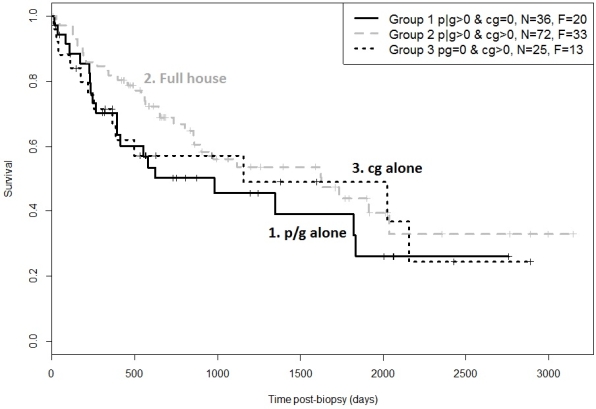Clinical Subclassifiation of ABMR Phenotypes: Recognizing Variation in Presentation
Alberta Transplant Applied Genomics Centre, Edmonton, Canada.
Meeting: 2015 American Transplant Congress
Abstract number: 33
Keywords: Biopsy, Kidney transplantation, Rejection
Session Information
Session Name: Concurrent Session: Kidney Antibody Mediated Rejection I
Session Type: Concurrent Session
Date: Sunday, May 3, 2015
Session Time: 2:15pm-3:45pm
 Presentation Time: 3:27pm-3:39pm
Presentation Time: 3:27pm-3:39pm
Location: Terrace I-III
The diagnosis of ABMR in kidney transplants is based on ptc-, g- and cg-lesions in biopsies and donor-specific antibody (DSA). To recognize the actual phenotypes observed, we studied 703 prospective indication biopsies three days to 35 years post transplant in USA and international centers. The p- and g-lesions had earlier onset but became less common in very late biopsies (figure 1 and 2); cg lesions were less before 5y but became the dominant lesions in very late biopsies, and had less correlation with DSA than pg lesions. In biopsies before one year, ptc- and g- lesions were often non-specific, with no DSA or ABMR before one year, often reflecting TCMR. We identified three classes of biopsies diagnosed as ABMR/TG: ptc/g with cg0 (“pg”); ptc/g plus cg (full house); and cg dominant (cg), based on conventional features. ABMR ptc/g occurred earlier than full house or cg but with extensive overlap. There was extensive variability but surprisingly there was no overall difference in rate of progression between kidneys with ptc/g, full house, and cg ABMR: all had high failure rate of about 50% by 3 years post biopsy, indicating that some ptc/g presentations can be unexpectedly aggressive. Cg ABMR was often “sterile” i.e. DSA and HLA antibody negative, compatible with either “burned out” ABMR or causes unrelated to HLA antibody. The molecular ABMR and Rejection Scores were highest in full house and ptc/g cases, but the cg ABMR were highest for a new classifier derived from cg lesions. Thus ABMR is a spectrum of presentations not adequately described by current terms “acute”, “chronic”, and “active”. Although ptc/g ABMR are earlier and cg ABMR are later at median time of presentation, the wide variability suggests that each case should be given an individual assessment of features and classified by its clinical features, without enforcing arbitrary categories. 

To cite this abstract in AMA style:
Halloran P, Lopez M, Salazar I, Chang J. Clinical Subclassifiation of ABMR Phenotypes: Recognizing Variation in Presentation [abstract]. Am J Transplant. 2015; 15 (suppl 3). https://atcmeetingabstracts.com/abstract/clinical-subclassifiation-of-abmr-phenotypes-recognizing-variation-in-presentation/. Accessed July 14, 2025.« Back to 2015 American Transplant Congress
